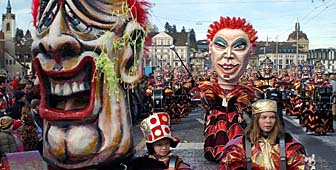Lucerne goes loopy over Fasnacht

After almost a week of non-stop revelry, carnival fever in Lucerne reached a colourful climax on Tuesday with an extravagant parade through the city.
“Fasnacht”, the local word for carnival, is the one time in the year when the people of Lucerne really let their hair down. Many residents close their shops and businesses for a week to join in the noise and merry-making, and to be part of a tradition dating back to the 15th century.
Some take part in “Guggenmusigen” or carnival bands; others choose to go it alone, with a simple guitar and a few tunes in their repertoire.
“There’s a lot of competition between the carnival bands these days,” Patric Graber, director of sales for Lucerne’s tourist board, told swissinfo. “Some bands even start practising in August the year before.”
Guggenmusigen
Groups performing pantomimes, dances and sketches also fill the streets. But not everyone feels the need to be part of a team: individual masked figures make their way along the banks of the river Reuss, hiding behind the anonymity of their masquerade. Birds, frogs, Vikings and teddy bears all stroll through the city in costumes that have taken weeks to prepare.
The bands wend their way through the cobbled streets, stopping here and there for an impromptu concert, a glass of wine or a coffee with schnapps.
The loud cacophony of rhythms created by all these musicians is intended to drive the winter spirits away.
To the outsider, Fasnacht has all the trimmings of a pagan tradition, but historically, in staunchly Catholic central Switzerland, religion once played a central role in the carnival celebrations.
Fasnacht fare
This was a time to fill one’s belly before the hardship of Lent, and you can still buy the greasy sausages and wafer-thin, sugary carnival cakes (Fasnachtskuechli), intended to fatten up the locals before the religious fasting began.
One of the more recent additions to Lucerne’s Fasnacht celebrations is the “Fat Monday” (Güdismontag) parade. It was started in 1927 by one of the city’s guilds of craftsmen, called the Wey Guild, who felt the carnival needed a new lease of life.
Fat Monday was conceived to poke fun at local politics and revisit the year’s most amusing events in Lucerne. It was set up in direct competition with last week’s “Dirty Thursday” (Schmutziger Donnerstag) parade, run by the Safran Guild, the Mask-lovers Society, the Fidelitas Society and some other smaller clubs.
The rivalry continued for more than 20 years until 1951 when four societies joined together to form the Lucerne Carnival Committee, which coordinates and runs the two parades. They are now almost identical, however the Wey Frog float only appears in Monday’s parade.
The crowning glory of Lucerne’s carnival is a giant parade of carnival bands, lights and lanterns on Mardi Gras (Güdisdienstag) evening. When dawn arrives, you can still find the odd straggler wending their way home.
A last drumbeat echoes through the cobbled streets of the old city, signalling that the ghosts of winter have finally been laid to rest and that spring is on its way.
by Julie Hunt

In compliance with the JTI standards
More: SWI swissinfo.ch certified by the Journalism Trust Initiative

You can find an overview of ongoing debates with our journalists here. Please join us!
If you want to start a conversation about a topic raised in this article or want to report factual errors, email us at english@swissinfo.ch.